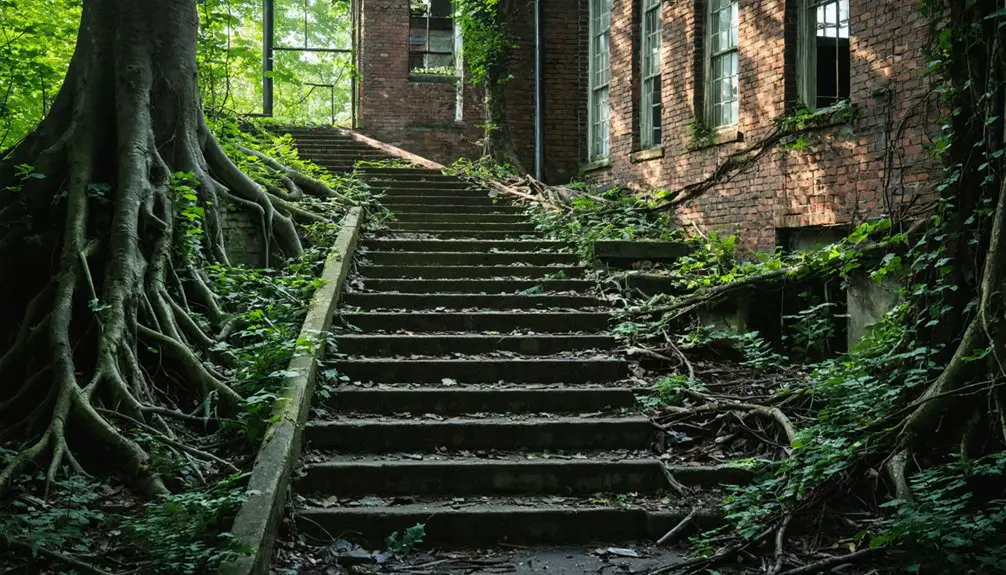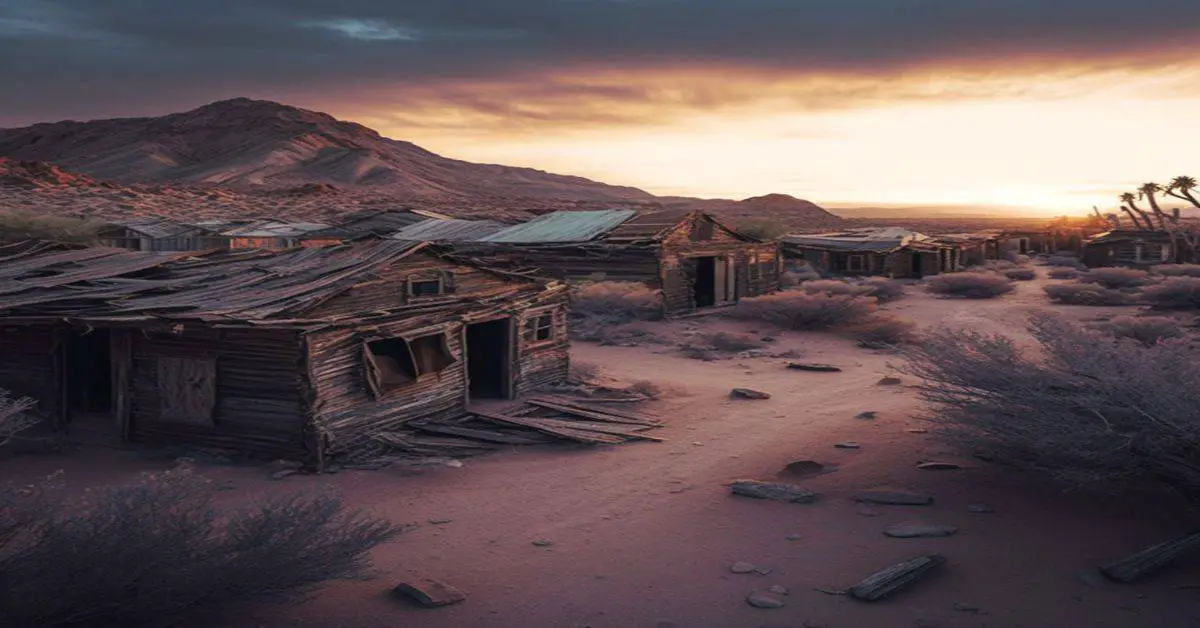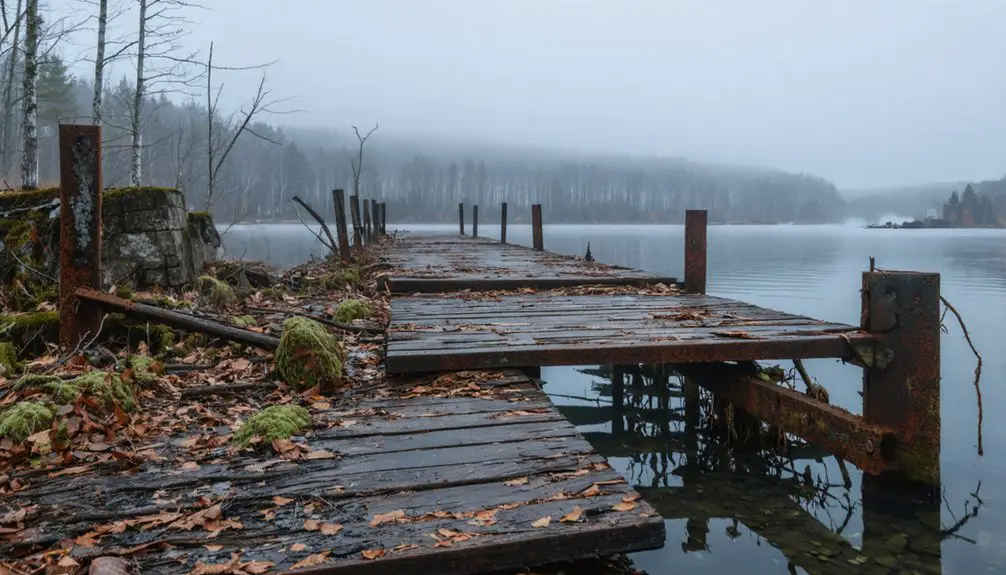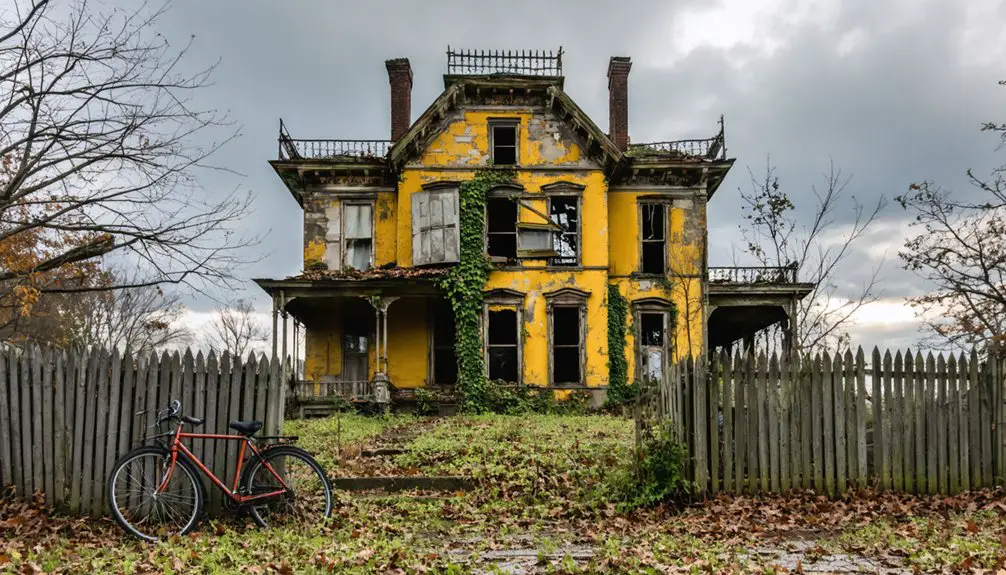You’ll find North and South Brother Islands in New York City’s East River, where Dutch settlers first claimed them in 1614. These abandoned islands housed Riverside Hospital from 1885 to 1963, treating infectious diseases and particularly quarantining Typhoid Mary. The site witnessed the tragic PS General Slocum disaster in 1904, which claimed 1,021 lives. Today, the crumbling hospital ruins and overgrown wilderness hide centuries of dark stories beneath their decay.
Key Takeaways
- North Brother Island’s abandoned Riverside Hospital complex, once a quarantine facility, stands in ruins as a testament to NYC’s medical history.
- The islands became uninhabited after Riverside Hospital closed in 1963, leaving behind deteriorating buildings and infrastructure.
- Both islands are now designated “Forever Wild” preserves, accessible only to authorized personnel for wildlife conservation efforts.
- Historic structures, including a lighthouse from 1868 and remnants of Jacob Ruppert’s summer estate, remain as ghostly artifacts.
- The islands served as quarantine facilities for infectious diseases, most famously housing Typhoid Mary until her death in 1938.
Early Dutch Origins and British Acquisition
Although Indigenous peoples likely visited the North and South Brother Islands, it wasn’t until 1614 that the Dutch West India Company officially claimed them.
Navigator Adriaen Block gave them their first European name, “De Gesellen,” meaning “the companions” or “the brethren.”
You’ll find they were also known as “duo de Gesellen” or “the Two Brothers” in Dutch, though they remained largely uninhabited due to a lack of fresh water sources.
In 1791, the islands were put up for sale at the Merchants Coffee House auction as a potential site for a pilot or entertainment house.
The islands changed hands when British ownership began in the late 1600s.
The Troubled Waters Around Brother Islands
If you’d traveled past Brother Islands in the late 1800s, you’d have encountered treacherous East River currents that made navigation especially dangerous around these small land masses.
The islands’ position in the Hell Gate section of the East River contributed to numerous shipwrecks and maritime disasters, including the notorious General Slocum steamship tragedy of 1904.
These challenging waters continue to create hazardous conditions for modern vessels, requiring careful navigation and leading authorities to restrict access to the islands’ deteriorating docks. A lighthouse built in 1869 helped guide ships through these dangerous waters, though maritime accidents still occurred frequently. Today, North Brother Island remains strictly controlled as a bird sanctuary, offering safe harbor to various shorebird species rather than ships.
Dangerous East River Currents
Three major factors make the waters around North and South Brother Islands among the most treacherous in New York Harbor.
First, you’ll encounter powerful tidal currents that reverse direction every six hours, creating turbulent currents and dangerous cross-flows. The infamous Hell Gate section lies just west of these waters, adding to the navigational challenges.
Second, the narrow channels between the islands (600-4,000 feet) concentrate these flows, making vessel navigation particularly challenging.
Third, the complex underwater terrain of Fordham gneiss and Inwood marble creates unpredictable whirlpools and swirls.
You’ll find the most hazardous conditions two hours after high water at The Battery, when Hudson River currents flow north while East River currents push west. During peak tidal cycles, current speeds can reach up to 5 knots.
The islands’ location also intensifies the “Spider” phenomenon – swirling currents that sweep up from The Battery, demanding exceptional piloting skills to navigate safely.
Historic Maritime Disasters
The treacherous waters surrounding Brother Islands have witnessed several maritime tragedies, with none more devastating than the PS General Slocum disaster of June 15, 1904.
You’ll find that this catastrophic event, which claimed 1,021 lives, exposed shocking failures in maritime safety and forever changed the area’s history.
The disaster unfolded in three critical phases:
- Fire erupted near the Lamp Room, spreading rapidly through the wooden vessel carrying 1,300 passengers.
- Captain Van Schaick’s decision to continue sailing allowed flames to intensify, trapping passengers aboard.
- North Brother Island’s quarantine hospital became ground zero for rescue operations and body recovery.
This tragedy sparked nationwide demands for historical accountability, leading to President Roosevelt’s investigation and sweeping reforms in maritime safety regulations. The victims were mostly women and children from the Saint Marks Lutheran Church on their annual summer excursion.
The disaster’s impact resonates today as a stark reminder of the East River’s deadly potential. The vessel’s inadequate safety measures included rotted fire hoses and inaccessible lifeboats, which severely hampered rescue efforts.
Despite modern maritime technology, steering through the treacherous waters around North and South Brother Islands remains a significant challenge for vessels today.
You’ll find complex tidal currents of the East River and narrow passages between the Bronx shore and Rikers Island demanding expert navigation skills.
Rocking the Boat, a local non-profit organization, provides specialized boat access for approved research visits.
If you’re planning to visit, you’ll face serious access challenges. The original ferry dock has eroded away, and there’s no functional landing infrastructure.
You’ll need special permits for any approach, as public access is prohibited by law. Even with permission, you’re confronted with shallow, rocky waters and ever-changing tidal conditions.
The islands’ status as protected bird sanctuaries further restricts development of new docking facilities, while decaying structures and submerged debris pose additional navigational safety risks.
The NYC Parks Department maintains strict oversight of the area as a designated wildlife reserve, adding another layer of access restrictions.
Rise of Riverside Hospital and Medical Legacy
Established in 1885 on North Brother Island, Riverside Hospital emerged as New York City’s strategic response to managing infectious diseases away from densely populated areas. The facility’s quarantine measures proved essential in protecting the city from epidemics, while setting precedents for disease control that other major cities would follow.
Riverside Hospital pioneered urban disease control, isolating contagious patients on North Brother Island to shield New York City from epidemics.
You’ll find the hospital’s remarkable evolution reflected in these key developments:
- Multiple specialized buildings arose, including pavilions for different diseases, a morgue, and even recreational facilities.
- The hospital treated thousands of patients with typhoid, tuberculosis, and smallpox, including the famous case of “Typhoid Mary.”
- A final major expansion occurred in 1943 with the Tuberculosis Pavilion, marking the peak of the hospital’s infrastructure before medical advances made it obsolete.
The Tragic Tale of Typhoid Mary
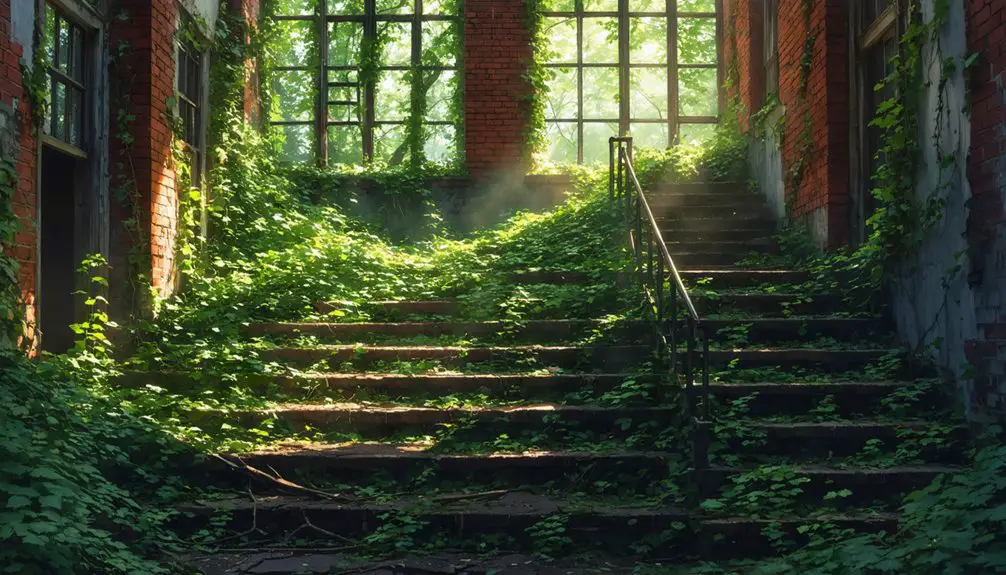
Among Riverside Hospital’s most infamous patients, Mary Mallon emerged as America’s first identified asymptomatic typhoid carrier in the early 1900s.
You’ll find her story intertwined with North Brother Island‘s history, where she spent 23 years in quarantine until her death in 1938.
As a cook for wealthy New York families, Mallon unknowingly spread typhoid through contaminated food, causing multiple outbreaks that infected 50 people and killed at least three.
When public health investigators identified her as the source, she refused to accept her carrier status or change professions.
After her initial arrest in 1907 and brief release in 1910, she continued cooking under different names.
A final typhoid outbreak in 1915 led to her permanent quarantine on North Brother Island, where she remained until pneumonia claimed her life.
General Slocum Disaster: A Dark Chapter
You’ll find one of America’s deadliest maritime disasters unfolded near North Brother Island on June 15, 1904, when the paddle steamer General Slocum caught fire with 1,340 passengers aboard.
The ship’s defective safety equipment, including rotted life preservers and inaccessible lifeboats, left passengers with few options as flames engulfed the vessel within 20 minutes of the fire’s outbreak.
Captain Van Schaick beached the burning ship on North Brother Island’s shore, where rescue efforts saved only 321 to 407 passengers while approximately 1,021 souls, mostly women and children from Manhattan’s Little Germany community, perished in the tragic event.
Maritime Tragedy Unfolds
On June 15, 1904, one of America’s deadliest maritime disasters unfolded in New York City’s East River when the passenger steamship General Slocum caught fire during a church excursion.
The vessel, carrying around 1,400 German-American passengers from St. Mark’s Evangelical Lutheran Church, was headed for a picnic at Locust Grove when tragedy struck.
The devastating sequence of events occurred rapidly:
- A fire ignited in the Lamp Room around 10 a.m., likely from a discarded cigarette.
- The flames spread uncontrollably within 20 minutes, exposing critical maritime safety failures.
- Failed life-saving equipment and untrained crew led to massive loss of life.
Within hours, over 1,000 lives were lost, devastating the German-American community of the Lower East Side.
The tragedy stands as a stark reminder of the importance of proper safety measures.
Rescue Efforts Fall Short
While rescue operations mobilized swiftly after the General Slocum caught fire, the scale of the disaster quickly overwhelmed available resources and responders.
You’ll find that despite heroic efforts from North Brother Island’s hospital staff and a flotilla of over 100 vessels, rescue failures mounted rapidly. The ship’s own fire hoses burst under pressure, and many rescue boats caught fire themselves while attempting to save passengers.
The tragic numbers tell the story: of 1,388 people aboard, only 431 survived.
You can trace these devastating losses to multiple factors – inadequate safety measures, untrained crew, and the captain’s eventual abandonment of the ship.
Even as doctors, nurses, and rescue boats arrived within minutes of the beaching, they couldn’t overcome the inferno that had already trapped hundreds below deck.
From Private Estate to Government Control
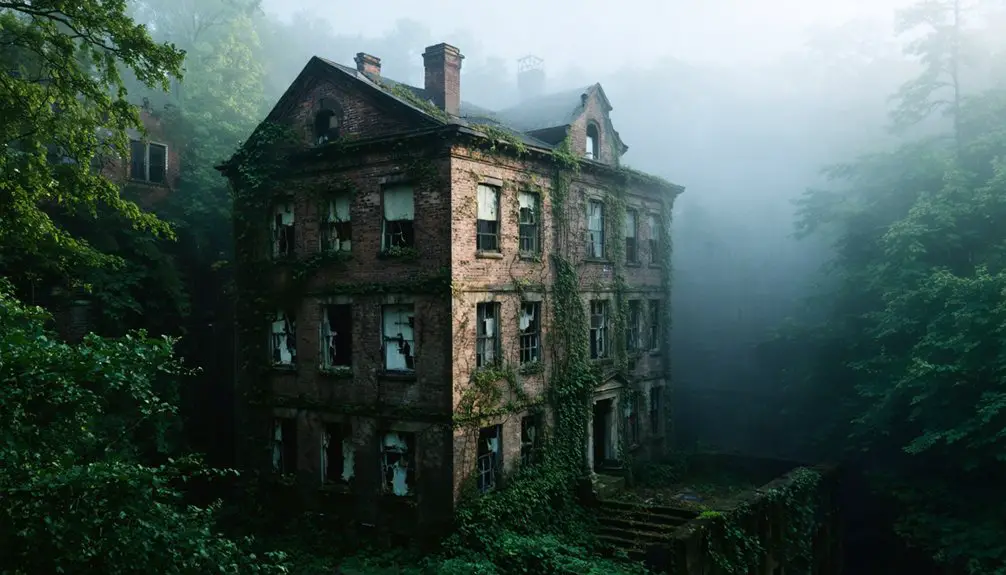
The Dutch West India Company‘s initial ownership of North and South Brother Islands in 1614 marked the beginning of a complex series of transfers spanning several centuries.
The shift from private ownership to government control unfolded through these key phases:
- James Graham’s 1695 acquisition from British authorities initiated a period of private ownership, though dangerous currents prevented development.
- Jacob Ruppert’s summer estate era ended with a fire in 1909, representing the last significant private residential presence.
- New York City’s purchase in the 1880s transformed North Brother Island into a quarantine facility with Riverside Hospital.
You’ll find that federal involvement began in 1868 with the lighthouse construction, but the most significant government shift occurred when NYC took control, establishing the island’s enduring institutional legacy that lasted until 1963.
Wildlife Sanctuary and Conservation Efforts
Since 2001, North and South Brother Islands have served as essential Forever Wild preserves under NYC Parks Department protection, creating one of New York City’s most significant urban wildlife sanctuaries.
The Brother Islands stand as vital Forever Wild havens in NYC, protecting endangered species within this thriving urban sanctuary.
You’ll find extensive wildlife conservation efforts here, including active removal of invasive plants and replanting of native species like sumac, dogwood, and American holly.
The islands’ habitat restoration has attracted diverse bird colonies, with South Brother Island becoming one of NYC’s largest wader nesting sites.
While black-crowned night herons abandoned North Brother by 2008, you can still spot barn swallows nesting in abandoned buildings.
The Trust for Public Land, Wildlife Conservation Society, and other partners manage these sanctuaries through federal funding, ensuring their preservation while restricting public access to protect sensitive ecosystems.
Abandoned Structures and Hidden History
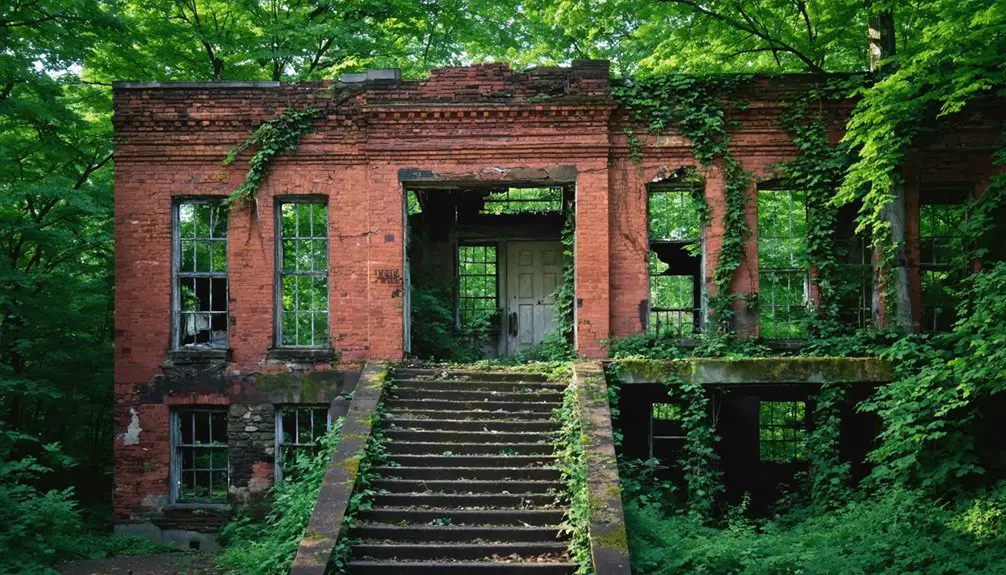
Beyond their natural sanctuary status, North and South Brother Islands harbor remnants of New York City’s complex past through their decaying structures.
You’ll find abandoned buildings scattered across the landscape, telling stories of isolation and public health measures from a bygone era.
- The 1885 Riverside Hospital complex, where Typhoid Mary spent nearly two decades in quarantine, stands in ruins with its wooden pavilions slowly being reclaimed by nature.
- A historic lighthouse with its mansard roof and octagonal tower, built in 1868, remains partially intact at the southern tip.
- The burnt remains of Jacob Ruppert’s summer home, which hasn’t been inhabited since a 1909 fire, hide artifacts of early private ownership.
These deteriorating structures serve as silent witnesses to the islands’ roles in quarantine, navigation, and private residence.
Ghost Stories and Urban Legends
Within the shadowy confines of North and South Brother Islands, chilling tales of supernatural encounters have persisted since the late 1800s.
You’ll find the most haunting stories centered around Riverside Hospital, where ghostly apparitions of former patients in hospital gowns roam the decaying halls. The tragic 1904 sinking of the PS General Slocum added another layer of paranormal activity, with witnesses reporting spectral figures walking on water and mysterious voices echoing across the shore.
Urban legends tell of souls trapped in eternal isolation, including Typhoid Mary’s restless spirit and the countless victims of forced quarantine.
Among the island’s wandering souls, Typhoid Mary and quarantined victims remain forever bound to their place of imprisonment.
Today, you might encounter unexplained whispers, glowing orbs, and sudden temperature drops around the abandoned structures. The islands’ reputation as a supernatural hotspot stems from their dark history of disease, death, and enforced exile.
Frequently Asked Questions
Are There Any Current Plans to Restore the Hospital Buildings?
You’ll find restoration efforts are limited, with only two buildings salvageable. Most hospital buildings are slated for demolition, though there’s a pending $30 million project to convert one structure for performing arts.
How Deep Is the Water Surrounding the Brother Islands?
Through the swirling currents, you’ll find water depths varying dramatically – from 15 feet near the island shores to 40 feet in the main East River channel, with dredged passages ranging 20-35 feet deep.
What Species of Birds Currently Nest on the Islands?
You’ll find Black-crowned Night-Herons, Great Egrets, Snowy Egrets, and Double-crested Cormorants on South Brother Island, while North Brother offers birdwatching opportunities for Ospreys in their natural nesting habitats.
Has Anyone Ever Successfully Lived on South Brother Island?
You won’t find any records of successful inhabitants on South Brother Island – it’s remained persistently uninhabited throughout history. Unlike its northern neighbor, the island’s always been too isolated and environmentally protected for settlement.
Do Any Remnants of Mary Mallon’s Personal Belongings Still Exist?
You won’t find any confirmed personal belongings of Mary Mallon today. While her historical significance remains through photos and documents, her actual artifacts haven’t survived or been preserved from her quarantine years.
References
- https://en.wikipedia.org/wiki/North_and_South_Brother_Islands_(New_York_City)
- https://www.untappedcities.com/the-top-10-secrets-of-nycs-abandoned-north-brother-island/
- https://faroutmagazine.co.uk/new-york-forgotten-north-brother-island/
- https://nyghosts.com/hauntings-of-north-brother-island/
- https://www.shelleynolden.com/about-north-brother-island/
- https://www.wttw.com/urbannature/new-yorks-deserted-island
- https://www.design.upenn.edu/sites/default/files/files/North Brother Island Final Report Part 2.pdf
- https://www.design.upenn.edu/sites/default/files/files/North Brother Island Final Report Part 1.pdf
- http://bronxink.org/parks-2018/brother-islands-access/
- https://captbbrucato.wordpress.com/2009/05/17/new-york-citys-east-river-and-hell-gate/
